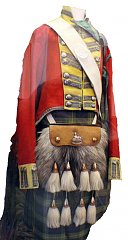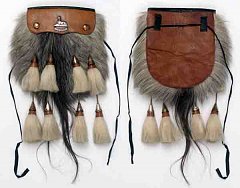|
-
16th March 21, 07:39 AM
#1
Great Kilt, Little kilt Historical information wanted
Can anyone provide information about when (time period) the British Army Highland Regiments officially (or otherwise) adopted the little kilt or the more modern kilt we know today, and discarded the great kilt. i opine it was sometime between the Napoleonic and Crimean wars (or earlier?), but this covers about 56 years and i was hoping someone might help me to narrow the period and make this number more manageable. Or correct me if my opinion is in error.
Thanks in advance to all who contribute.
Jacques
"I know of no inspiration to be got from trousers."
Lt. Col. Norman MacLeod, QOCH, c. 1924
-
-
16th March 21, 08:14 AM
#2
 Originally Posted by Jacques

Can anyone provide information about when (time period) the British Army Highland Regiments officially (or otherwise) adopted the little kilt or the more modern kilt we know today, and discarded the great kilt. i opine it was sometime between the Napoleonic and Crimean wars (or earlier?), but this covers about 56 years and i was hoping someone might help me to narrow the period and make this number more manageable. Or correct me if my opinion is in error.
Thanks in advance to all who contribute.
Jacques
The Feileadh Beag was certainly being worn by the military from the 1760s, possibly earlier, but the Feileadh Mor (Belted Plaid ) continued to be worn until the late 18th century.
By the 1790s the military had generally adopted a sewn kilt with a Half Plaid being added for parade wear. Whilst Wilsons' 1819 Key Pattern Book included plaid settings for various regiments, these seem to have been anachronistic by that date and there is no evidence of the Belted Plaid being used. Nor is there any evidence of its use during the Napoleonic era or later.
-
The Following 3 Users say 'Aye' to figheadair For This Useful Post:
-
16th March 21, 09:29 AM
#3
Peter,
There is a lot of confusion over the difference between Feileadh Beag and Feileadh Mor.
It is not unusual to hear the names as if they were interchangeable names for the same garment.
Perhaps it would be helpful for you to define the two or describe the difference.
-
The Following User Says 'Aye' to Steve Ashton For This Useful Post:
-
16th March 21, 09:58 AM
#4
Thank you for your input and information.
i have been reviewing a few more books since my first post and discovered a quote from Sgt James Anton, 42nd RHR, 1815, upon his return to Edinburgh; "It now consists of a yard and one quarter, a useless shred of cloth, like a child's pinafore reversed, and pinned to the back of the shoulder." And also a young Ensign Hackett, 1853, prior to leaving Portsmouth for Crimea; "with the feather bonnets, belted plaids hanging from the left shoulder....they did look very well indeed." i'm not entirely certain is Ensign Hackett is describing the same article as Sgt Anton.
i guess my interest lies with when the Highland regiments stopped using the great kilt, the +/- 8 yard double width plaid and began exclusively wearing the kilt which appears much as todays modern kilts.
Thanks much
Jacques
"I know of no inspiration to be got from trousers."
Lt. Col. Norman MacLeod, QOCH, c. 1924
-
-
16th March 21, 10:26 AM
#5
 Originally Posted by Jacques

i guess my interest lies with when the Highland regiments stopped using the great kilt, the +/- 8 yard double width plaid and began exclusively wearing the kilt which appears much as todays modern kilts.
Broadly speaking, c1800. Here's Ensign Bramwell's 92nd uniform made in 1815: sewn 4 yard box pleated kilt with half plaid.

Last edited by figheadair; 16th March 21 at 10:29 AM.
-
The Following User Says 'Aye' to figheadair For This Useful Post:
-
16th March 21, 10:37 AM
#6
 Originally Posted by figheadair

Thank you Peter.
So there's my missing link i suppose. Great kilt, Kilt with half plaid, and a little kilt of sorts; closer to its modern cousin. i wonder what Sgt Anton was on about.
Last edited by Jacques; 16th March 21 at 10:47 AM.
Reason: additional comment
"I know of no inspiration to be got from trousers."
Lt. Col. Norman MacLeod, QOCH, c. 1924
-
-
16th March 21, 10:49 AM
#7
 Originally Posted by figheadair

That is one massive and impressive sporran. More in there, I'd wager, than his handkerchief.
Rev'd Father Bill White: Retired Parish Priest & Elementary Headmaster. Lover of God, dogs, most people, joy, tradition, humour & clarity. Legion Padre, theologian, teacher, philosopher, linguist, encourager of hearts & souls & a firm believer in dignity, decency, & duty. A proud Canadian Sinclair.
-
The Following 3 Users say 'Aye' to Father Bill For This Useful Post:
-
16th March 21, 11:23 AM
#8
 Originally Posted by Father Bill

That is one massive and impressive sporran. More in there, I'd wager, than his handkerchief.
Actually, it was all about show; form rather than function. The bag itself is relatively modest.

-
The Following 2 Users say 'Aye' to figheadair For This Useful Post:
-
16th March 21, 11:36 AM
#9
 Originally Posted by Steve Ashton

Peter,
There is a lot of confusion over the difference between Feileadh Beag and Feileadh Mor.
It is not unusual to hear the names as if they were interchangeable names for the same garment.
Perhaps it would be helpful for you to define the two or describe the difference.
Steve, a good point. The two terms, as you rightly say, often used interchangeably.
I tend to follow Bob Martin’s definition in referring to the separate lower half of the plaid that was worn loosely pleat, possible with a draw-string and no sewn in pleats as a feileadh beag. Anything that has sewn in pleats, irrespective of the style Bob called a kilt.
A few early kilts survive but no example of a feileadh beag, nor a complete 18th century feileadh mor does. Given the Proscription restrictions and the fact that both styles were essentially a length of cloth, it is easy to understand how the material could have been recycled and so not survived in an identifiable form.
We are not helped in our understanding by the historical use of kilt to describe what is assumed to have been a feileadh beag. The Act of Proscription forbade the wearing of, amongst other things, ‘….the plaid, philibeg, or little kilt…’. Nowhere does it refer to the plaid as the belted plaid or feileadh mor, and certainly not the great kilt as some re-enactors call it.
-
-
16th March 21, 12:41 PM
#10
 Originally Posted by figheadair

Actually, it was all about show; form rather than function. The bag itself is relatively modest.

I rather thought as much, but much appreciated for the photographic evidence, Peter!
Rev'd Father Bill White: Retired Parish Priest & Elementary Headmaster. Lover of God, dogs, most people, joy, tradition, humour & clarity. Legion Padre, theologian, teacher, philosopher, linguist, encourager of hearts & souls & a firm believer in dignity, decency, & duty. A proud Canadian Sinclair.
-
The Following User Says 'Aye' to Father Bill For This Useful Post:
 Posting Permissions
Posting Permissions
- You may not post new threads
- You may not post replies
- You may not post attachments
- You may not edit your posts
-
Forum Rules
|
|





















Bookmarks